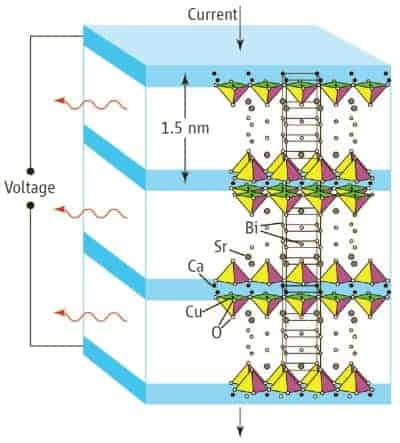
Electromagnetic radiation in the terahertz range has a host of potential applications, from detecting explosives to diagnosing cancer. But sandwiched between microwaves and the infrared, terahertz radiation is not easy to generate — its frequencies are too high to be produced by semiconductor devices, yet too low to be produced by solid-state lasers. Researchers from the US, Turkey and Japan, however, have shown that this “terahertz gap” could be filled by exploiting the in-built Josephson junctions present in high-temperature superconductors.
Josephson junctions, which comprise two superconductors separated by a thin insulator, are well known for displaying odd quantum effects. In particular, applying a fixed voltage across a junction sets up an oscillating supercurrent, causing the junction to emit photons at a frequency matching the superconductor’s energy gap. In other words, Josephson junctions can produce electromagnetic radiation.
Unfortunately the energy gap in lab-made Josephson junctions, based on conventional superconductors such as niobium, is too small to produce terahertz radiation. Worse still, individual junctions do not generate much power. Researchers have tried rigging up arrays of junctions to boost the power, but it is difficult to synchronize the junctions to make a coherent beam of radiation in which all wavelengths are in-phase.
Layered structure
Ulrich Welp at Argonne National Laboratory and colleagues now claim that both of these problems can be solved with high-temperature superconductors. Unlike conventional superconductors, high-temperature superconductors do not need to be made into Josephson junctions because they naturally contain them throughout a unique layered structure. They also have comparatively large energy gaps that lend to producing radiation well into the terahertz range.
Crucially, however, Welp’s group have discovered a simple way to synchronize the phase of these “intrinsic” Josephson junctions in high-temperature superconductors to emit milliwatts of power (Science 318 1291). “A wide variety of sensing and imaging applications can be envisioned for terahertz radiation in this power range,” said Welp.
A wide variety of sensing and imaging applications can be envisioned for terahertz radiation in this power range
The researchers worked with the high-temperature superconductor Bi2Sr2CaCu2O8, also known as BSCCO, which has stacks of intrinsic Josephson junctions formed between interspersed layers of superconducting CuO2 and insulating BiO and SrO. Applying a voltage across a BSCCO sample makes all of these intrinsic junctions emit electromagnetic radiation at a certain frequency — but not necessarily in-phase.
Similarly to a laser, the trick making the emission in-phase is to vary the voltage until the emitted frequency matches the resonant frequency of the cavity. At this frequency, the electric field cancels itself out in all but the in-phase mode, so that the junctions are “encouraged” to be synchronized. At first only a few junctions emit in-phase, but as more latch on the radiation intensifies, causing yet more junctions to resonate until finally the whole stack is in-phase.
Welp and colleagues fabricated samples of BSCCO with a height of about 300-µm. Such dimensions give a stack of some 200,000 intrinsic Josephson junctions, generating 0.5 µW of radiation at frequencies up to 0.85 THz. Welp told physicsworld.com that by optimizing the technique he hopes the power can be increased to 1 mW. This level of power could be used, for example, in airports to search for the spectral “fingerprints” of explosives, although he admitted that commercial devices using his group’s emitters are some way off. “Generally, the higher the available power, the better the signal-to-noise ratio is and the faster and more reliable active imaging and screening of people could be performed,” Welp said.



